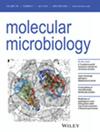一种新型能力诱导的链球菌肽聚糖水解酶的自我免疫是由一种类似于femm转移酶的蛋白介导的
IF 2.6
2区 生物学
Q3 BIOCHEMISTRY & MOLECULAR BIOLOGY
引用次数: 0
摘要
粘蛋白水解酶(或肽聚糖水解酶)在细菌中发挥着多种作用,从受控重塑细菌细胞壁到溶菌剂。在链球菌中,一些此类水解酶与能力诱导的自相残杀有关,在这个过程中,细菌会杀死密切相关的细胞,以释放可在自然转化过程中吸收的 DNA。在这里,我们对 ScrM 进行了表征,这是一种来自痢疾链球菌的保守的能力诱导型金黄色葡萄球菌水解酶,由一个 CHAP 结构域、一个 SH3b 结构域和一个未表征的 C 端结构域 (CCD) 组成。ScrM 对化脓性链球菌和唾液腺链球菌具有溶菌活性。荧光融合的显微分析表明,ScrM特异性地定位在敏感细胞的细胞中部,其结合和定位主要由CCD介导。在能力诱导过程中,由于表达了类似于 Fem-transferase 蛋白的 ScrI,细胞对 ScrM 产生了免疫力。我们通过 LC-MS/MS 发现,ScrI 在肽聚糖肽间桥中用 Thr 代替了 Ala,这反过来又阻止了 ScrM 与细胞中层的结合,从而保护细胞在能力诱导过程中不会自我分解。ScrM和ScrI在化脓性链球菌病原体中是保守的,代表了这些细菌细胞壁生物发生过程中的新角色,可能成为开发新型抗菌策略的平台。本文章由计算机程序翻译,如有差异,请以英文原文为准。

Self-Immunity Towards a Novel Competence-Induced Streptococcal Peptidoglycan Hydrolase is Mediated by a Fem-Transferase-Like Protein
Murein hydrolases (or peptidoglycan hydrolases) play diverse roles in bacteria, from controlled remodeling of the bacterial cell wall to lytic agents. In streptococci, some such hydrolases have been associated with competence-induced fratricide, a process where bacteria kill closely related cells to release DNA that can be taken up during natural transformation. Here, we characterize ScrM, a conserved competence-induced murein hydrolase from Streptococcus dysgalactiae comprising a CHAP domain, an SH3b domain, and an uncharacterized C-terminal domain (CCD). ScrM displayed lytic activity against pyogenic and salivarius group streptococci. Microscopy analysis of fluorescent fusions revealed that ScrM specifically localizes to midcell of sensitive cells, with binding and localization mediated primarily by CCD. Upon competence induction, cells became immune to ScrM due to expression of ScrI, a Fem-transferase-like protein. We show by LC–MS/MS that ScrI incorporates Thr in place of Ala into the interpeptide bridges of peptidoglycan, which in turn prevents ScrM binding to midcell, thereby protecting the cells from self-lysis during competence. ScrM and ScrI are conserved among pyogenic streptococcal pathogens and represent new players in the cell wall biogenesis of these bacteria that may form a platform for the development of novel antimicrobial strategies.
求助全文
通过发布文献求助,成功后即可免费获取论文全文。
去求助
来源期刊

Molecular Microbiology
生物-生化与分子生物学
CiteScore
7.20
自引率
5.60%
发文量
132
审稿时长
1.7 months
期刊介绍:
Molecular Microbiology, the leading primary journal in the microbial sciences, publishes molecular studies of Bacteria, Archaea, eukaryotic microorganisms, and their viruses.
Research papers should lead to a deeper understanding of the molecular principles underlying basic physiological processes or mechanisms. Appropriate topics include gene expression and regulation, pathogenicity and virulence, physiology and metabolism, synthesis of macromolecules (proteins, nucleic acids, lipids, polysaccharides, etc), cell biology and subcellular organization, membrane biogenesis and function, traffic and transport, cell-cell communication and signalling pathways, evolution and gene transfer. Articles focused on host responses (cellular or immunological) to pathogens or on microbial ecology should be directed to our sister journals Cellular Microbiology and Environmental Microbiology, respectively.
 求助内容:
求助内容: 应助结果提醒方式:
应助结果提醒方式:


